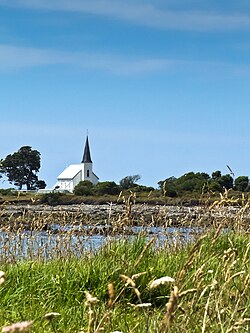Raukokore | |
|---|---|
 Raukokore's Anglican church | |
 Interactive map of Raukokore | |
| Coordinates: 37°38′38″S177°52′35″E / 37.644°S 177.8764°E | |
| Country | New Zealand |
| Region | Bay of Plenty |
| Territorial authority | Ōpōtiki District |
| Ward | Coast Ward |
| Community | Coast Community |
| Electorates | |
| Government | |
| • Territorial authority | Ōpōtiki District Council |
| • Regional council | Bay of Plenty Regional Council |
| • Mayor of Ōpōtiki | David Moore [1] |
| • East Coast MP | Dana Kirkpatrick [2] |
| • Waiariki MP | Rawiri Waititi [3] |
| Area | |
• Total | 100.96 km2 (38.98 sq mi) |
| Population (2023 Census) [5] | |
• Total | 345 |
| • Density | 3.42/km2 (8.85/sq mi) |
Raukokore is a small settlement close to the East Cape in the northeastern North Island of New Zealand. It is located on State Highway 35, close to the mouth of the Raukokore River, 40 kilometres to the west of Hicks Bay.
Contents
Raukokore's most notable feature is its Anglican church, Christ Church, a landmark of the East Cape region, which stands isolated close to the shore of Papatea Bay. The church was named as one of the East Cape/Gisborne region's "101 must-do" sites by the New Zealand Automobile Association. [6] The church was designed and built by Duncan Stirling in 1894. Stirling married local Raukokore chief Mihi Kōtukutuku in the church in 1896. The church is listed as a Category 1 Historic Place by Heritage New Zealand. [7]
Raukokore is administered by the Ōpōtiki District Council.